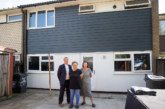
Leonie Onslow from BUFCA offers advices on improving the energy efficiency and performance of social housing stock.
Registered social landlords still have a major role to play in the shift towards a more energy-efficient housing stock, highlighted by the number of occupants still struggling to afford basic living expenses, including home heating. This occurs despite public sector housing being amongst the most efficient in the country with 10% or less failing to meet the minimum Decent Homes Standards at any one time.1
Social housing providers can make the most of funding schemes such as the Energy Company Obligation (ECO) to pay for energy efficiency measures. The ECO scheme is due to be extended from October 2018 to March 2022 with a particular focus on reducing fuel poverty. In Scotland the HEEPS Loan Scheme for Registered Social Landlords is also open until 31st July 2018 for new applications in 2018/19 providing funding for energy saving improvements to housing stock.
Local authorities and housing associations may view these funding schemes as an opportunity to increase the energy efficiency of their housing stock with little cost to themselves. This is one way of upgrading the total housing stock to meet local authority and Decent Homes standards.
In 2015, there were over 2.5m fuel poor households in England, according to the Government’s Fuel Poverty Detailed Tables published in 2017. The most effective way of tackling this is to increase energy efficiency performance.
 Potential savings
Potential savings
Walls and lofts or roofs provide the most potential for energy savings. Spray-applied or injected polyurethane foam can be used to insulate walls and roofs. Cavity walls can be insulated to provide high levels of thermal performance. The process is also used to bond the two leaves together in cases of wall tie failure. Injected polyurethane is often used as a cavity wall insulant when other materials are not suitable, for instance in hard-to-treat housing or properties in flood plain areas.
Around 1.3m properties have non-standard, unfilled cavity walls, according to research published by the Department for Business, Energy & Industrial Strategy in November 2017. Insulating these properties is trickier because standard cavity insulants are generally not advised. However, injected polyurethane foam could be the solution for many. In the roof space, spray applied polyurethane foam can be used on the underside of the tiles to prevent heat loss rising up through the roof. It is essential that the roof is sound prior to installation.
It is recommended that installer members of the British Urethane Foam Contractors Association are employed for spray or injected polyurethane foam installations. Members operate to high standards of workmanship and abide by the Association’s Code of Professional Practice, which aims to further good technical and professional conduct and promotes sound relationships between members and their customers.
“The ECO scheme is due to be extended from October 2018 to March 2022 with a particular focus on reducing fuel poverty.”
Structural integrity
At the Whitings, a tower block in Oaks Lane, Ilford, Kershaw Insulation, a BUFCA installer member, was appointed on behalf of Redbridge Homes to install cavity insulation into the Whitings — a Grade 2 listed tower block comprising 61 flats where the lack of existing insulation had been contributing to excessive energy bills for its tenants.
A particular challenge of the job was the narrow width of the cavity, measuring less than 50mm wide between the inner and outer leaf of the exterior walls. Kershaw addressed this by installing Technitherm, a polyurethane system from Isothane, between the two building skins. The process involved drilling holes in the external walls through which the insulation was then injected. The system automatically bonded both the inner and outer leaf of the walls together, giving the whole building greater structural integrity.
The work took just eight weeks to complete with minimal disruption to residents who were able to stay in their homes throughout. The installation was fully funded, with no cost to residents who will now save money on their heating bills.
A series of technical datasheets are freely available on the association’s website to meet current Building Regulations with recommended depths of insulation for various applications. These provide guides to ascertain U-value calculations, construction detailing and dew point analysis, for example. However, actual calculations must be carried out on an individual basis.
The British Urethane Foam Contractors Association has a list of installers who are skilled in the installation of sprayed or injected polyurethane foam. When choosing a member, specifiers can be assured of the highest standards of quality and service.








